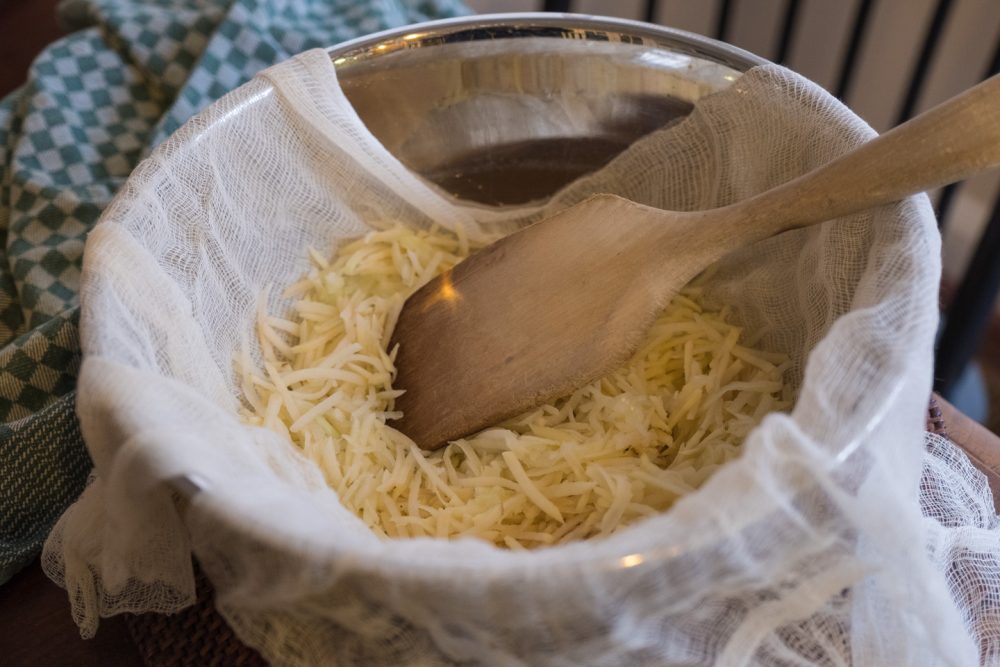by Vivian Henoch
Latkes, the Yiddish word for the potato pancakes we know and love, are the iconic food of Chanukah, the Festival of Lights and Oil. Fried until golden in a pool of vegetable oil, drained on paper towels, latkes are best when eaten still sizzling, cooled just enough so as not to burn the tongue. Serve with sour cream and apple sauce (or homemade apple-cherry compote in tribute to Michigan tastes) and you have happy punims all around.
Essentially, making a great plate of latkes doesn’t take much practice — you grate, you mix, you fry, you eat. But just like the tapestry of our Jewish peoplehood is made up of many different backgrounds from around the world, the latke has its special variations, too.
You’ll never know unless you try, yes?
If it sounds like a shonda to go beyond the humble potato and matza meal only recipe, make this the year you outdo yourself and give these tasty latke varieties a spin. Make plenty. Because, really, any way you eat them, there’s nothing like a platter of potato pancakes to inspire excess.
- Russian: Beet and Potato Latkes with Horseradish Cream from Rachael Ray In Season
- Greek: Feta and Spinach Latkes with Tzatzki from Food Network
- Israeli: Vegan Sweet Potato Latkes with Yogurt and Sesame. Recipe below from our former community Shaliach, now honorary Detroiter for life, Nina Yahalomi Klevitsky
- Epicurian: Mini Latkes Topped with Smoked Salmon, Caviar and Tarragon Crème Fraiche with Lemon Slice from Epicurious
- Farmer’s Market: Potato and Parsnip Latkes Topped with Horseradish and Dill from Smitten Kitchen
- Indian: Curry Spiced Latkes with Mint and Yogurt Chutney from Food52
- Dessert: Apple Latkes (Topped with Caramel Sauce) from Smitten Kitchen
- Switzerland Crisp Rösti Potatoes (essentialy a giant latke) from Fine Cooking
Nina’s Israeli Sweet Potato Latkes
For a vegan and gluten-free recipe, we’ve substituted 2 tablespoons tahini for each egg, and use red lentil or rice flour.
Makes 25-30 small latkes:
- 2 medium onions
- 4-5 medium potatoes (you can use beet/zucchini/sweet potatoes etc. instead of the potato)
- 2 tablespoons of raw Tahini (before you mix it with water)
- 1 teaspoon salt
- A pinch of fresh ground black pepper
- 3 tablespoons of red lentil/rice/spelt flour (spelt flour is not gluten free)
- Finely chop the onions
- Peel the potatoes and coarsely grind the potatoes.
- Squeeze the grated potatoes in your hands and transfer to the bowl with the chopped onion.
- Add the rest of the ingredients
- Heat half-deep oil in a heavy skillet over medium heat.
- Make pancakes and fry for 4-5 minutes on each side. It is important that the oil is not too hot.
- Serve immediately with sour cream or yogurt with some chives or parsley.

Notes for newbies
- For best results, choose russet potatoes. Apparently their high starch content is ideal for holding together that combination of crispy-crunch outside and creamy inside
- For convenience, don’t bother peeling the potato. Through the blade of the grater, you will hardly notice the skins.
- For speed, use a food processor with the shredding blade for grating. There are those who argue for hand-grating. Fine for small quantities. But if you’re serving a crowd, save your arm the workout. (For sticklers on this, you can double the work here. Shred potatoes again using the processing blade on the pulse setting for a finer texture, taking care not to overwork and grind the pieces.)
- Drain as much of the liquid as possible from the potatoes using a colander or cheese cloth. The drier the mixture, the better for frying.
- Use matzo meal or a combination of matzo meal and flour as a binder.
- Use vegetable oil. Better yet, use peanut oil that can reach higher temps without scorching. You want to maintain oil at about 350°.
- Drain latkes on paper towels and serve immediately. You can also keep them warm in a low oven for an hour or more. In the fridge, they can keep for a day or two or in the freezer, separated and well wrapped, for up to two weeks. Reheat in a single layer on a cookie sheet in a 400° oven.




